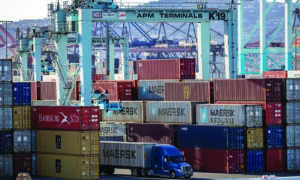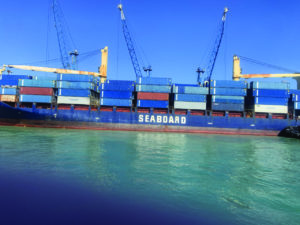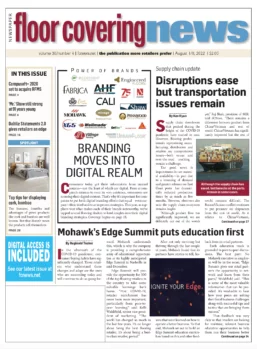 Supply chain slowdowns that peaked during the height of the COVID-19 pandemic have started to ease. However, flooring professionals representing manufacturing, distribution and retailers say transportation issues—both ocean and over-the-road trucking—remain a challenge.
Supply chain slowdowns that peaked during the height of the COVID-19 pandemic have started to ease. However, flooring professionals representing manufacturing, distribution and retailers say transportation issues—both ocean and over-the-road trucking—remain a challenge.
The good news is improvement in raw material availability—in part due to a lessening of demand and greater reliance on East Coast ports—has dramatically reduced production times by as much as five months. However, observers also note the supply chain ecosystem remains fragile.
“Although product flow has significantly improved, we are definitely not out of the woods yet,” Raj Shah, president of MSI, told FCNews. “There remains a difference between product from China/Vietnam and rest of world. China/Vietnam has significantly improved but the rest of world remains difficult. The Russia/Ukraine conflict continues to put pressure on shipments from the rest of world. As it relates to China/Vietnam, although availability and capacity have significantly improved, rates are still six times pre-pandemic rates. In addition, there remains issues domestically.”
Interestingly, the improvement in product flow by ocean freight has exacerbated bottlenecks at the ports. Santa Fe Springs, Calif.-based Tri-West, a top 20 distributor, reported that Asian factories experienced a lead-time change from seven to nine months during most of 2020 and 2021 to three to four months in early 2022. This dramatic reduction meant scores of containers with original ETAs for the second half of 2022 arrived much earlier than expected.
“This put distribution in a warehousing crunch,” said Dave White, vice president of sales and marketing for Tri-West. “Limited drivers and chassis to move the containers from the port—and those inland freight costs from port to warehouse—have increased significantly and vary with each delivery. Distribution is currently sitting on more than desired levels of inventory.”
While product capacity has improved with raw material supply stabilizing, transportation—both ocean and over-the-road trucking—remain a challenge, flooring executives noted. “The ports continue to be congested and finding truckers to pull material to the final destination remains difficult,” said Dan Natkin, CEO of Bauwerk Group. “We are beginning to see some easing here and anticipate it will continue to ease into the fall/winter.”
Congestion at the West Coast ports prompted some importers to divert containers to the East Coast, giving West Coast ports some breathing room. However, manufacturers are still facing equipment and driver shortages. Observers referred to AB5, a California law that effectively reclassified large numbers of workers in the state as employees rather than independent contractors. Until recently, truckers were exempted. However, on June 30, a court injunction was lifted, and now truckers are included in AB5. That has led to protests throughout the state. The Oakland port, for example, was shut the past few days due to the protests.
“With the AB5 issue in California, we will see driver shortages and rising costs as well for domestic freight,” said Billy Ko, CEO of Johnson Hardwood, which is headquartered in California.
In addition to that, distributors are also dealing with ocean freight charges that remain extremely high by historical standards—a situation magnified by turmoil in eastern Europe. “Trade sanctions on Russian goods, while understandable, certainly have added to inflationary pressures that we see impacting almost all goods—both directly in terms of raw material cost inputs and indirectly in terms of increased domestic freight costs,” said Scott Rozmus, president/CEO of FlorStar Sales, Romeoville, Ill. “Basically, it has become a little easier to get stuff, but that stuff costs a lot more now.”
Despite the challenges, there are positive signs ahead—although executives are proceeding cautiously. “With the overall slowdown seen in many industries as well as strong stocking levels, we believe the supply chain issues will subside over the next few months,” MSI’s Shah predicted. “But the overall system is extremely fragile so any small shift can cause flare-ups again. We continue to recommend to customers to get in front of projects and plan in advance.”
Retailers weigh in
 Many flooring retailers have witnessed an easing of supply chain disruptions—which, in turn, has led to fewer back orders. “Orders are being filled much faster than previously,” said Ted Gregerson, president of Ted’s Abbey Flooring, Aniston, Ala. “We are also beginning to hear about reductions in the actual cost of freight pertaining to containers.”
Many flooring retailers have witnessed an easing of supply chain disruptions—which, in turn, has led to fewer back orders. “Orders are being filled much faster than previously,” said Ted Gregerson, president of Ted’s Abbey Flooring, Aniston, Ala. “We are also beginning to hear about reductions in the actual cost of freight pertaining to containers.”
In fact, container prices have fallen in the last year. According to Shifl, a company that tracks freight commerce, container ocean spot freight rates have plateaued at around $7,000-$8,000/40-foot container ship since April 2022—down from a high of around $17K-$18K/40-foot container ship from China to the U.S. West Coast in January 2022.
Still, freight charges remain a pain point for many flooring retailers. A case in point is Craig Phillips, president of The Flooring Edge, with three Ohio retail businesses. He said his freight charges are up 70% year over year. “While our business is up, a bulk of the 70% is cost increases,” he said. As a result, Phillips—much like other retailers who have been affected—has instituted a transaction fee on retail sales to help offset some of the costs and to protect against margin erosion.
Other dealers have included a standard freight charge on every order, while some have moved to a per-square-foot freight fee for hard surface to address the new surcharges. “We have no issue with the freight coming from the U.S. supplier as we basically combine the actual freight and surcharge into one lump sum—which is used for our cost to work up our margin,” said John Taylor, president of Taylor Carpet One Floor & Home, Fort Myers, Fla. “The surcharge on the ocean freight is the issue. We believe this should be part of the cost of the product regardless of the amount. We have had to add extra percentages in our formulas to offset this so as not to incur additional margin erosion.”
During these inflation-wearing times, retailers say forging a close working relationship with a trusted supplier partner has never been more important. “We were fortunate as our core suppliers did a great job of servicing our business,” said Phil Koufidakis, president of Phoenix-based Baker Bros.

